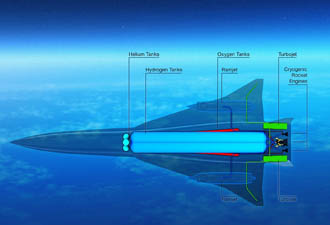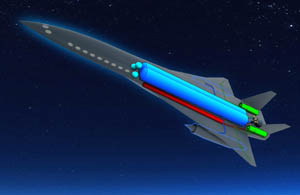Plans for a hypersonic jet that could reduce your flying time from Tokyo to Paris or Tokyo to LA in less than 2.5 hours by 2050, and which would also run on clean fuels such as biofuel and liquid hydrogen, have been unveiled at the Paris Air Show this week.
Aerospace group EADS, which owns brands such as Airbus, Eurocopter and Astrium, has presented its concept study for the future aircraft, the ZEHST – an acronym for zero emission high supersonic transport – that it expects could be flying long-haul routes by 2050 as a standard aircraft and running on clean fuels such as biofuel and liquid hydrogen, as well as emitting less noise pollution.
The company put a four-metre model of the plane on display at the Paris Air Show.
With the European Commission’s roadmap ‘Flightpath 2050’ having set targets of reducing aircraft CO2 emissions by 75pc, along with reductions of mono-nitrogen oxides by 90pc and noise levels by 65pc, compared to year 2000 levels, EADS said that not only will long-haul airliners of the future have to be fast they will have to meet the air transport’s industry’s environmental protection goals.

The ZEHST concept, which could be running as a standard aircraft by 2050
“The initial concept represents a propulsion system architecture which is driven by flight safety considerations and by the requirements to minimise exhaust gas and noise emissions, in particular to mitigate the sonic boom,” said Jean Botti chief technical officer at EADS. “It’s not a Concorde, but it looks like a Concord,” he added at the Paris Air Show.
“We are on a very early stage with this research programme. First series planes flying with technology resulting from this concept will not fly before 2040,” he said.
The ZEHST, which will fly to an altitude of up to about 32km, will carry between 50 and 100 passengers.

The plane’s two turbojet engines will run on biofuel
EADS said the thrust required for the ZEHST’s initial flight phase – with the normal takeoff from a standard runway through to the initial cruise, the climb to 5km altitude and acceleration to Mach 0.8 – will be provided by two high-power, low-bypass turbojet engines without afterburners that operate on biofuel.
It said the ignition and operation of two small liquid hydrogen/liquid oxygen-powered booster rocket engines followed by the ignition of a larger one will enable the aircraft’s continued steep climb towards the cruising altitude and the acceleration up to a speed of Mach 2.5.
Four times the speed of sound
Once the plane reaches a 23km altitude, it will employ two “airbreathing hydrogen-fuelled ramjets” for the aircraft’s cruise flight at beyond Mach 4, which is four times the speed of sound.
When the ZEHST approaches its destination, the aircraft’s turbojets will reignite at an altitude of 10km for the approach to a normal landing.
EADS said that a design criterion of the ZEHST concept is that passengers “should have a ‘normal’, comfortable in-flight experience without requiring any special equipment or training.
“For a short period of time during the steep rocket engine-powered climb and acceleration, ZEHST passengers would feel mild acceleration forces, not exceeding 1.2g,” the group added.
The ZEHST is a joint project with Japan.
Photo: The ZEHST concept plane unveiled by EADS at the Paris Air Show this week